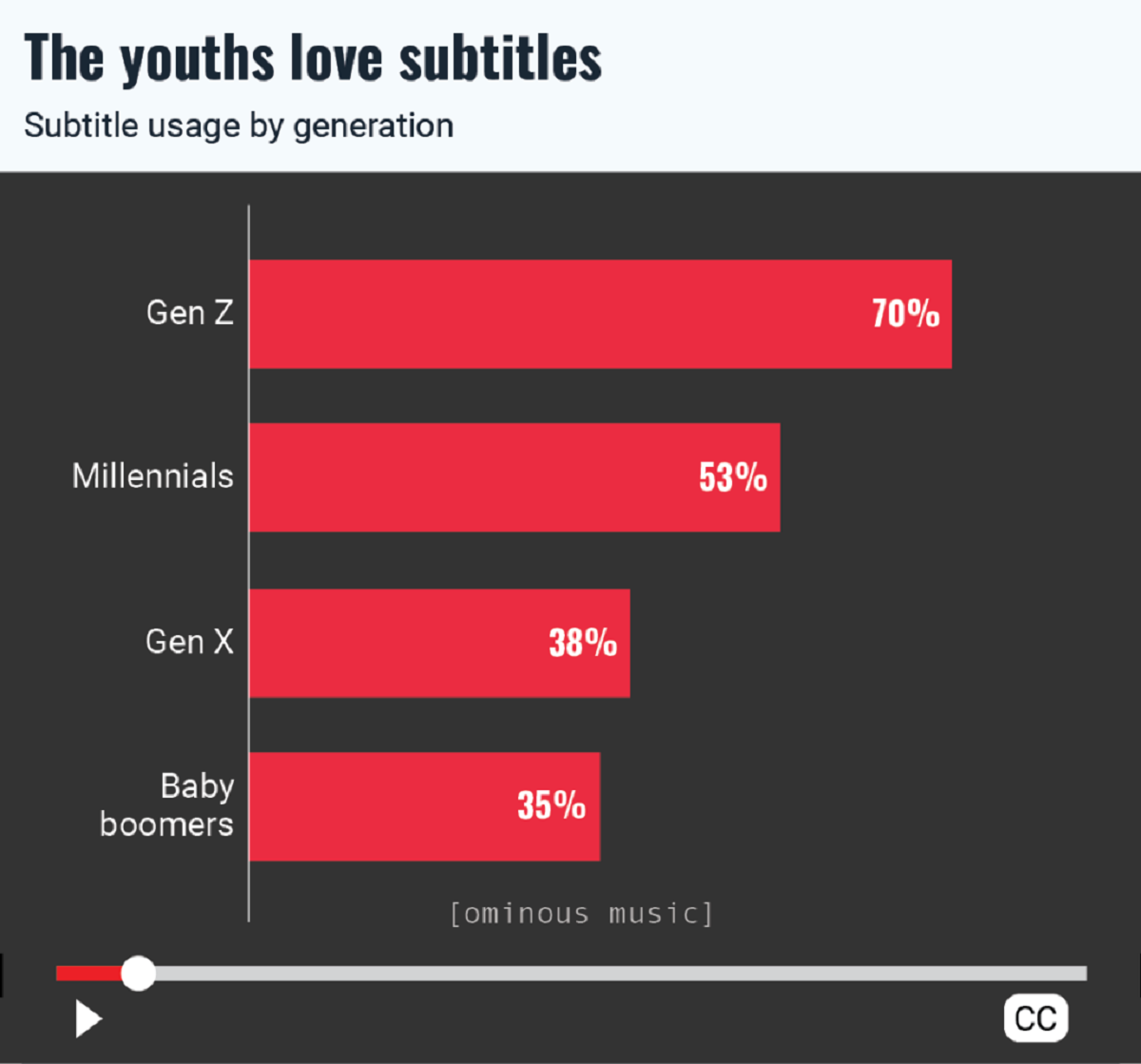Introduction
Subtitles have become an increasingly common feature in the digital age, with millions of people opting to use them while watching videos and movies. This widespread adoption of subtitles is not limited to the hearing-impaired or non-native speakers; even individuals who have no trouble with hearing or language proficiency are embracing subtitles. This phenomenon is particularly evident in the younger generation, commonly referred to as Generation Z (Gen Z), who are known for their affinity for technology and multimedia consumption.
So, why does Gen Z use subtitles? The answer lies in a combination of factors, ranging from accessibility and multitasking habits to learning strategies and cultural differences. By understanding the motivations behind Gen Z’s use of subtitles, we can gain valuable insights into how technology is shaping our viewing experiences and communication habits.
In this article, we will explore the various reasons why Gen Z chooses to utilize subtitles. We will delve into the impact of subtitles on accessibility, comprehension, and language development. Additionally, we will discuss how subtitles can enhance the overall viewing experience and address concerns related to privacy. By delving into these aspects, we hope to shed light on the underlying reasons for Gen Z’s affinity for subtitles.
The Importance of Subtitles
Subtitles play a significant role in today’s multimedia landscape, extending beyond their traditional purpose of aiding the hearing-impaired. They have become a crucial tool for enhancing accessibility, improving comprehension, and accommodating various viewing preferences. Let’s explore some key reasons why subtitles have gained such importance in the Gen Z demographic.
Accessibility for All: Subtitles ensure that content is accessible to individuals with hearing impairments. By providing written text alongside audio, subtitles empower the deaf and hard-of-hearing community to engage with videos and movies on equal footing. This inclusivity factor is crucial in developing a more diverse and inclusive media landscape.
Multitasking and Distractions: Gen Z is notorious for their ability to multitask and their inclination towards utilizing multiple screens simultaneously. Subtitles allow them to follow the dialogue and storyline while engaging in other activities. Whether it’s scrolling through social media, browsing the web, or even studying, subtitles enable them to stay connected and informed without missing out on the content.
Improving Comprehension and Retention: Subtitles can significantly enhance comprehension, especially when dealing with complex or unfamiliar subjects. By providing a visual representation of the spoken words, subtitles reinforce understanding, helping viewers grasp crucial details, whether it’s the name of a character or technical jargon. Moreover, studies have shown that reading the text while listening can improve information retention, allowing Gen Z to better absorb and recall the content.
Learning and Language Development: Subtitles have a positive impact on language learning and development. For non-native speakers, they provide valuable support in understanding and interpreting unfamiliar words or phrases. Furthermore, subtitles can expose Gen Z to different accents and dialects, contributing to their language skills and cultural awareness. By reading subtitles alongside the dialogue, they can sharpen their listening and reading abilities simultaneously.
Cultural and Regional Differences: In an increasingly interconnected world, Gen Z embraces content from various cultures and regions. However, language barriers can pose a challenge. Subtitles bridge this gap by facilitating the understanding of different languages, allowing Gen Z to explore content from international sources, expand their horizons, and foster cross-cultural communication.
Enhancing the Viewing Experience: Subtitles have the potential to enhance the overall viewing experience for Gen Z. They provide additional context, aid in character identification, and clarify ambiguous dialogue. Subtitles also add a visual element to the video, making it more engaging and immersive. With subtitles, Gen Z can fully immerse themselves in the content and appreciate the nuances that may otherwise be missed.
In summary, subtitles have become an indispensable tool for Gen Z, offering accessibility, improved comprehension, language development, and an enhanced viewing experience. Their usage extends beyond the hearing-impaired community, catering to the diverse needs and preferences of this tech-savvy generation. As we delve deeper into the reasons behind Gen Z’s preference for subtitles, we gain a deeper appreciation for the impact of technology on the way we consume media and communicate.
Accessibility for All
One of the most significant benefits of subtitles is their ability to make content accessible to people with hearing impairments. For individuals who are deaf or hard of hearing, subtitles provide a text-based representation of the spoken words, allowing them to follow along and understand the dialogue. This inclusivity factor is essential in creating a more diverse and inclusive media landscape.
Subtitles go beyond merely providing accessibility for the hearing-impaired. They also cater to individuals who may have difficulty understanding certain accents, dialects, or pronunciations. By having the dialogue displayed on screen, viewers can better grasp the intended message, even if they struggle to catch every word. This is particularly relevant in a globalized world where people are exposed to content from different cultural backgrounds and linguistic nuances.
Moreover, subtitles can benefit individuals with cognitive or learning disabilities. People with conditions such as dyslexia may find it challenging to process auditory information efficiently. Subtitles present the information visually, allowing them to read and comprehend the content at their own pace. This visual reinforcement can significantly improve their understanding and enjoyment of the media.
It’s important to note that subtitles are not limited to individuals with disabilities. Many individuals without hearing impairments choose to utilize subtitles as a personal preference. Some may find it easier to process and retain information by reading along with the dialogue. Others may find it helpful in noisy environments or situations where they cannot play the audio out loud.
Subtitles also assist individuals who are learning a new language. When watching foreign language content, having subtitles in their native language or a language they’re more proficient in helps them understand the dialogue and improve their vocabulary. Subtitles expose learners to the correct spelling and pronunciation of words and phrases, aiding their language acquisition process.
Lastly, subtitles promote accessibility for individuals who are in situations where they cannot play audio out loud. Whether in public spaces such as libraries or while commuting, subtitles allow for discreet consumption of content without disturbing those around them. This convenience factor allows individuals to enjoy their favorite shows or movies without compromising their social settings or interactions.
In summary, subtitles play a crucial role in ensuring accessibility for all. They empower the hearing-impaired, cater to diverse linguistic backgrounds, assist individuals with learning disabilities, aid language learners, and provide convenience in various environments. By embracing subtitles, Gen Z not only fosters inclusivity but also opens up a world of possibilities for individuals to engage with content and connect with one another regardless of their differences.
Multitasking and Distractions
Generation Z is notorious for their ability to multitask, often engaging in multiple activities simultaneously. With the rise of technology and ubiquitous access to digital devices, Gen Z has become adept at dividing their attention among different screens and tasks. Subtitles, in this context, serve as a valuable tool that allows them to maintain their multitasking habits while still fully engaging with the content they are consuming.
By utilizing subtitles, Gen Z can follow the dialogue and storyline of a video or movie, even while engaging in other activities. Whether it’s scrolling through social media, checking emails, or even doing homework, subtitles provide a means to stay connected and informed without missing out on the content at hand. This flexibility enables them to make the most of their time and seamlessly integrate media consumption into their busy lifestyles.
Another benefit of subtitles in a multitasking environment is the ability to overcome distractions. In today’s digital age, distractions abound, from notifications on smartphones to background noise in coffee shops. Subtitles offer a way to keep up with the content despite external disruptions, allowing Gen Z to maintain focus and fully comprehend the dialogue. The text-based nature of subtitles provides a visual anchor amid a sea of distractions.
Furthermore, subtitles can be especially helpful for individuals with attention deficit disorders or those who struggle with maintaining concentration for prolonged periods. The presence of subtitles on screen provides an additional layer of engagement, helping to keep their focus and prevent their minds from wandering.
It’s worth mentioning that subtitles also help in scenarios where the audio quality is compromised. Whether due to technical issues, poor sound reproduction, or watching content in a noisy environment, subtitles ensure that the dialogue is crystal clear, reducing the impact of external factors that might hinder the audio experience. This feature is particularly valuable for Gen Z, who consume media on various platforms and in diverse contexts.
However, it is important to strike a balance when it comes to multitasking and using subtitles. While subtitles can enhance the ability to multitask, excessive multitasking itself can lead to diminished focus and reduced overall comprehension. Gen Z must be mindful of their multitasking habits to ensure that they are not sacrificing the quality of their media consumption experience.
In summary, Gen Z’s affinity for subtitles can be attributed to their inclination towards multitasking and the need to overcome distractions. Subtitles provide a means to engage with content while simultaneously juggling multiple activities. By embracing subtitles, Gen Z maximizes their productivity and ensures comprehension even in distracting environments. However, it is crucial to strike a balance between multitasking and focusing on the quality of the media consumption experience.
Improving Comprehension and Retention
Subtitles offer significant benefits when it comes to improving comprehension and retention of the content being watched. By providing a written representation of the dialogue, subtitles reinforce understanding and help viewers grasp crucial details that they may have missed otherwise.
For Gen Z, who consume a vast amount of content across different genres and platforms, subtitles play a vital role in enhancing comprehension. Whether it’s a complex storyline, technical jargon, or fast-paced dialogue, subtitles provide a visual aid that ensures no detail goes unnoticed. They act as a safety net, catching any missed information and serving as a reference if confusion arises. Subtitles can clarify ambiguous dialogue, helping viewers follow the plot and better understand the intentions of the characters.
Moreover, incorporating subtitles into the viewing experience has been shown to improve information retention. Research suggests that reading text while simultaneously listening to audio can enhance memory and recall. By engaging both the visual and auditory senses, subtitles create a multi-modal experience that strengthens the connection between the spoken words and their meaning. This can be particularly beneficial when learning new concepts or studying educational content.
Another advantage of subtitles in terms of comprehension is their ability to aid viewers with learning disabilities. Individuals with conditions such as dyslexia or attention deficit disorders may find it challenging to process auditory information alone. Subtitles provide a visual reinforcement, allowing them to read the dialogue at their own pace, comprehend the content more effectively, and retain the information for longer periods of time.
In addition, subtitles are beneficial for individuals who are non-native speakers of the language being used in the content. When watching videos or movies in a foreign language, having subtitles in their native language or a language they are comfortable with helps them understand the dialogue more accurately. Subtitles expose viewers to correct spelling, sentence structure, and pronunciation, thus contributing to their language learning journey.
Furthermore, subtitles can also assist individuals with different learning preferences. Some people are visual learners, meaning they absorb information better through visual aids. Subtitles provide a visual representation of the spoken words, catering to this learning style and enhancing their overall understanding and retention of the content.
In summary, subtitles play a crucial role in improving comprehension and retention for Gen Z. They serve as a safety net, ensuring no crucial details are missed and clarifying ambiguous dialogue. By engaging multiple senses and catering to different learning preferences, subtitles bolster information retention and make the content more accessible to individuals with learning disabilities or non-native speakers. Incorporating subtitles into the viewing experience enhances the overall understanding and enjoyment of the content being consumed.
Learning and Language Development
Subtitles have a significant impact on learning and language development, making them a valuable tool for Generation Z. Whether they are watching content in their native language or exploring foreign languages, subtitles provide numerous benefits that contribute to their linguistic growth.
For non-native speakers, subtitles offer valuable support in understanding and interpreting unfamiliar words or phrases. By displaying the translation or a transcription of the dialogue, subtitles bridge the language gap and facilitate comprehension. This exposure to different vocabulary and sentence structures aids in language acquisition and helps expand their linguistic capabilities.
Subtitles can also expose Gen Z to various accents, dialects, and regional differences in language. This exposure enhances their ability to understand and appreciate linguistic diversity. By reading subtitles alongside the spoken dialogue, they become more attuned to nuances in pronunciation, intonation, and rhythm. This improves their listening skills and helps develop a more rounded understanding of the language being spoken.
Moreover, subtitles play a significant role in improving reading comprehension skills. While watching subtitled content, Gen Z engages in simultaneous reading and listening, which strengthens their reading abilities. The visual reinforcement of the written text can help them associate the spoken words with their written counterparts, improving their overall reading fluency and accuracy.
Furthermore, subtitles can be an effective tool for language learners who wish to study independently. By providing a visual aid and allowing learners to pause, rewind, and repeat specific parts, subtitles enable them to practice their listening and reading skills at their own pace. Subtitles also offer a means of assessing their understanding and progress, making it easier to identify areas that require further study and practice.
Importantly, subtitles can contribute to cultural awareness and appreciation. When watching content from different cultures or regions, subtitles provide valuable context and facilitate a deeper understanding of cultural nuances. Learning about the customs, expressions, and idiomatic phrases through subtitles broadens Gen Z’s cultural perspectives and fosters cross-cultural communication.
Lastly, subtitles have been found to be beneficial for individuals with learning disabilities, such as dyslexia. For these individuals, reading subtitles provides a consistent form of text that they can easily process and comprehend, enhancing their overall learning experience.
In summary, subtitles play a crucial role in learning and language development for Generation Z. They support non-native speakers in understanding unfamiliar words and accents, improve reading skills, and facilitate independent language study. Subtitles also contribute to cultural awareness and are particularly helpful for individuals with learning disabilities. By utilizing subtitles, Gen Z enhances their language skills, expands their vocabulary, and embraces the diverse linguistic landscape of the media they consume.
Cultural and Regional Differences
The appeal of subtitles extends beyond language barriers, as they play a significant role in bridging the gap between different cultures and regions. Generation Z embraces content from diverse cultures and regions, and subtitles are a powerful tool that facilitates understanding and appreciation of these cultural and regional differences.
When watching content from different cultures, subtitles provide an essential context that aids in understanding cultural nuances and references. Cultural expressions, idiomatic phrases, and wordplay can be difficult to decipher without proper context. Subtitles help bridge this gap by providing translations and explanations, enabling Gen Z to fully grasp the richness and depth of different cultural aspects portrayed in the media they consume.
Subtitles also assist in overcoming language barriers that exist between different regions within a country. Regional accents and dialects can pose challenges for individuals who are not familiar with them. Subtitles enable Gen Z to understand and appreciate content originating from different parts of the world, even if they are not accustomed to the specific regional language variations.
Furthermore, subtitles allow Gen Z to explore content from international sources and expand their horizons. Through subtitles, they can access films, TV shows, and documentaries from different countries, experiencing diverse storytelling styles, cinematography, and cultural perspectives. This exposure broadens their understanding of the world, fostering curiosity, empathy, and a global outlook.
In addition, subtitles can be a powerful tool for preserving and promoting indigenous languages. Indigenous communities often face the risk of their language and cultural heritage being lost over time. Subtitling content in indigenous languages helps in their revitalization efforts, ensuring that these languages are not forgotten and providing opportunities for broader accessibility and appreciation.
Moreover, subtitles enable cross-cultural communication and understanding. They allow individuals from different cultural backgrounds to engage with content produced in another language, fostering connections and breaking down barriers. Subtitles encourage dialogue and bridge gaps, leading to a more inclusive and interconnected society.
It’s important to note that while subtitles aid in understanding and appreciating different cultures and regions, they should be accurate and culturally sensitive. The quality of subtitles plays a crucial role in ensuring an authentic and respectful representation of the content being translated.
In summary, subtitles play a vital role in bridging cultural and regional differences. They provide essential context, facilitate understanding of cultural nuances, and enable Gen Z to explore content from diverse cultures and regions. Subtitles contribute to cross-cultural communication, preserve indigenous languages, and promote a more inclusive and interconnected society. By embracing subtitles, Gen Z embraces cultural diversity and broadens their horizons, cultivating a global perspective.
Enhancing the Viewing Experience
Subtitles play a crucial role in enhancing the overall viewing experience for Generation Z. They go beyond their traditional purpose of aiding comprehension and accessibility by adding an additional layer of engagement and immersion to the content being consumed.
One way subtitles enhance the viewing experience is by providing additional context and clarity. Subtitles help viewers better understand the dialogue, especially in situations where the audio quality may be unclear. Whether it’s due to background noise, accents, or rapid speech, subtitles ensure that no crucial details are missed, enhancing comprehension and preventing any confusion that may arise from unclear audio.
Additionally, subtitles aid in character identification, particularly in productions with large ensembles or complex storylines. By clearly displaying character names next to their dialogue, subtitles make it easier for viewers to follow the interactions and relationships between different characters. This feature enables Gen Z to forge a deeper connection with the story and its characters, enhancing their overall engagement with the content.
Subtitles also have the ability to clarify ambiguous dialogue. There are instances where the spoken words may be muffled, whispered, or spoken in slang or colloquialisms, making it challenging for some viewers to understand the intended meaning. Subtitles provide a written representation of the dialogue, eliminating any ambiguity and ensuring that viewers fully grasp the intended message.
Moreover, subtitles have a visual element that can make the viewing experience more engaging and immersive. The text on the screen adds a layer of visual stimulation, capturing the viewer’s attention and making the content more visually dynamic. This visual reinforcement can enhance the emotional impact of key scenes, create emphasis on important dialogue, or draw attention to specific details within the frame.
Furthermore, subtitles can contribute to the aesthetics of the content being consumed, especially in foreign language films or shows. Many viewers appreciate the aesthetic beauty of the written language and find joy in seeing subtitles integrated into the visual composition of the screen. Stylistically designed subtitles can add a unique touch to the overall viewing experience, elevating the content aesthetically and enhancing its artistic appeal.
It is worth mentioning that while subtitles enhance the viewing experience for many, personal preferences may vary. Some viewers may prefer a more immersive experience without the distraction of subtitles, while others find subtitles essential for complete engagement.
In summary, subtitles enhance the viewing experience for Generation Z by providing additional context, aiding character identification, clarifying ambiguous dialogue, adding visual appeal, and contributing to the overall aesthetic of the content. By incorporating subtitles into the viewing experience, Gen Z can fully engage with the content, immerse themselves in the story, and appreciate the nuances that may otherwise be missed.
Privacy Concerns
While subtitles offer numerous benefits, it is important to address the privacy concerns that may arise with their usage. As Generation Z increasingly embraces subtitles in their media consumption, it is crucial to be aware of the potential privacy implications that can accompany this practice.
One significant concern pertains to the source and nature of the subtitles being used. There are various subtitle files available on the internet that may be downloaded and used alongside media content. However, it is essential to exercise caution when obtaining subtitles from unofficial sources. These files could potentially contain malware, viruses, or other forms of malicious software that can compromise the security of the device or personal data.
Additionally, subtitles can pose a risk when it comes to online streaming platforms. Some streaming services may rely on community-generated subtitles, often provided by volunteers. While many of these subtitles are accurate and helpful, there is always a possibility of inaccuracies or malicious intent, as they are not always vetted or monitored by the platform. These subtitles can inadvertently contain errors, misleading translations, or even offensive or inappropriate content.
Another aspect to consider is the potential for data privacy concerns when using subtitles. Some platforms may collect data on the viewing habits of users, including the subtitles they utilize. This data can be used for targeted advertising or shared with third parties, raising concerns about privacy and data security. It is important for users to familiarize themselves with the privacy policies of the platforms they use and make informed decisions about the information they choose to disclose.
Furthermore, there may be concerns related to the accessibility of subtitles for individuals with disabilities. While subtitles provide valuable support for the hearing-impaired, accessibility options for subtitles, such as font size, color contrast, or compatibility with assistive technologies, may not always meet the needs of all individuals. This can result in exclusion for those who require specialized accessibility features.
It is crucial for Gen Z and users of subtitles to be vigilant and take measures to ensure their privacy and security. Using reputable sources for subtitles, such as official streaming platforms or trusted subtitle providers, can minimize the risk of malware or malicious software. Staying up to date with security updates and utilizing reliable security software on devices can also provide an added layer of protection.
Additionally, being aware of privacy settings and options on streaming platforms can help users control their data and who has access to it. Reading and understanding the privacy policies and terms of service of these platforms can provide valuable insights into how user data is collected, used, and shared.
In summary, while the use of subtitles offers numerous advantages, it is essential to be mindful of the privacy concerns associated with their usage. The risk of malware or viruses from unofficial sources, inaccuracies or inappropriate content in community-generated subtitles, data privacy concerns, and limitations in accessibility options are all factors to consider. Taking precautions, utilizing reputable sources, and being aware of privacy settings can help mitigate these concerns and ensure a safer and more secure viewing experience.
Conclusion
Subtitles have become an integral part of the media consumption experience for Generation Z, offering a range of benefits and shaping their viewing habits. From enhancing accessibility for the hearing-impaired to accommodating multitasking behaviors and improving comprehension, subtitles play a vital role in meeting the diverse needs and preferences of this tech-savvy generation.
Subtitles not only provide accessibility for individuals with disabilities but also cater to the language learning and cultural appreciation of Gen Z. By offering translations, they bridge language barriers and enable viewers to explore content from different cultures and regions. Subtitles foster inclusivity, broaden perspectives, and strengthen cross-cultural communication.
Furthermore, subtitles enhance the overall viewing experience by providing context, aiding character identification, clarifying dialogue, adding visual appeal, and contributing to the artistic composition of the content. They create a more immersive and engaging experience, allowing Gen Z to fully connect with the storyline and appreciate the details that may otherwise be missed.
However, it is important to address privacy concerns associated with subtitles. Users must exercise caution when obtaining subtitles from unofficial sources to avoid potential security risks. Additionally, maintaining awareness of privacy settings, reading the terms of service, and utilizing reputable sources can help mitigate privacy risks and safeguard personal data.
In summary, the extensive use of subtitles by Generation Z reflects their desire for inclusivity, accessibility, and enhanced media consumption experiences. Subtitles not only facilitate understanding and language acquisition but also foster cultural awareness and cross-cultural communication. As technology continues to evolve, subtitles will likely continue to play a crucial role in shaping the way we consume and engage with media.

























